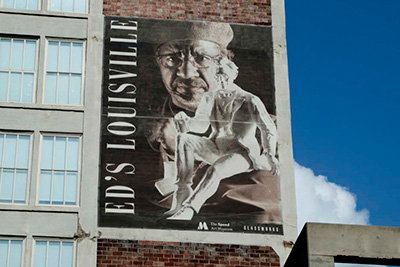"For the Roses" by Sharon Matisoff, 19x36in, oil on canvas (2017)
“Painting allows me to transform my perceptions of the world into portraits and figurative compositions.” — Sharon Matisoff
"Self-Portait" by Sharon Matisoff
Sharon Matisoff likes to paint portraits, but as an artist in Kentucky, the temptation of thoroughbred horse racing as a subject is inevitable. “Although I’ve always painted people, recently I discovered the joys of equine painting. Now I primarily divide my artistic attention between these two subjects. Horses are poetry in motion and I aim to capture their grace and power when I paint them. It is gratifying to me that my portraiture skills are also useful in portraying the myriad ways in which people interact with horses. I feel as though my life as an artist is just beginning.”
Matisoff has been painting for years, but being newly retirement affords her the time to double down on her studio practice. Her slightly heightened sense of color is grounded in naturalism, and her sensitive observation of detail, which has always been a key element of her portraiture, is put into good use in her behind the scenes images of the world of horses. Her perspective on the racing form of the horse and jockey are adept, but the fact that her sensibility is drawn to the more workaday aspects of the equine world is telling.
"Catching Up" by Sharon Matisoff, 19x36in, pastel on sanded paper (2017)
"Chillin'" by Sharon Matisoff, 27x19in, pastel on sanded paper (2017)
“I often work in pastel when I’m so inspired that I don’t want to stop and mix colors or stretch a canvas. The desire to paint is so strong that I must immerse myself in a painting all at once. Pastel painting allows me to be fearless with the elements of art in the most lyrical way. Oil painting is a language that I learned later in life, and so demands a more considered approach. With the elaborate preparation that oil painting requires, I work in this medium when I feel very deeply about a subject and pastel is too ephemeral to convey the depth or complexity of the subject. Armed with these media, I feel as though I can interpret the subjects that touch my soul.”
Matisoff will be one of the featured artists in the Fall Equine Show at the Brown Gallery in the Brown Hotel. The show will be on display from September 1, 2017 through January 1, 2018.
Hometown: Oak Park, Michigan
Education: BA in Psychology from California State University-Northridge; Studied art at the Art Center College of Design (Pasadena, California)
Gallery Representation: Jessie's Art Gallery and Custom Framing (Frankfort, KY)
Website: http://www.sharonmatisoff.com/
"Before the Race" by Sharon Matisoff, 19x36in, pastel on sanded paper (2017)
"Wild Blue" by Sharon Matisoff, 24x24in, oil on canvas (2017)
Written by Keith Waits. Entire contents copyright © 2017 Louisville Visual Art. All rights reserved.
Are you interested in being on Artebella? Click here to learn more.























